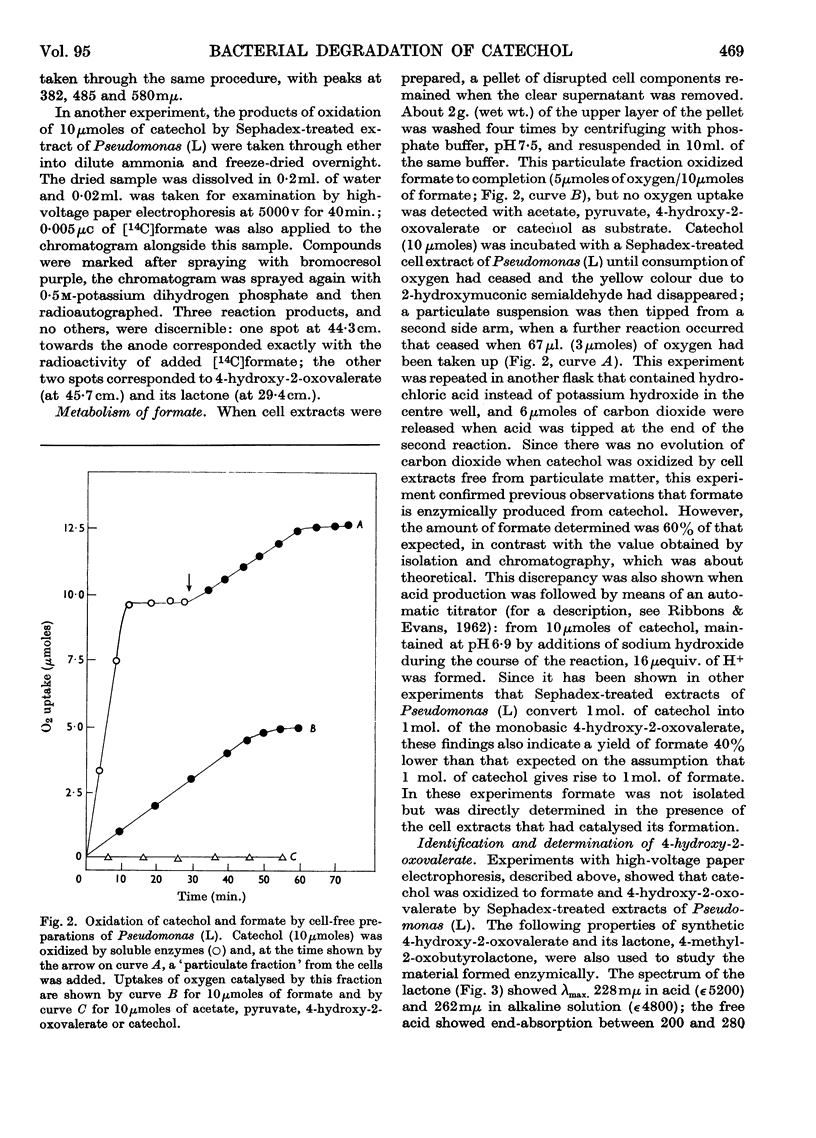Abstract
1. Two strains of Pseudomonas were grown with phenol and used to prepare cell extracts that metabolized catechol with the transient formation of 2-hydroxymuconic semialdehyde. 2. One of these preparations catalysed the conversion of 1mol. of catechol into 1mol. each of formate and 4-hydroxy-2-oxovalerate. 3. A method for the determination of 4-hydroxy-2-oxovalerate is described, together with some properties of this compound and its 2,4-dinitrophenylhydrazone. 4. Another partially purified cell extract converted 1mol. of 4-hydroxy-2-oxovalerate, formed enzymically from catechol, into 1mol. each of acetaldehyde and pyruvate. This aldolase had a pH optimum of about 8·8, was stimulated by Mg2+ ions and appeared to attack only one enantiomer of synthetic 4-hydroxy-2-oxovalerate.
Full text
PDF








Selected References
These references are in PubMed. This may not be the complete list of references from this article.
- CAVALLINI D. The coupled oxidation of pyruvate with glutathione and cysteine. Biochem J. 1951 Jun;49(1):1–5. doi: 10.1042/bj0490001. [DOI] [PMC free article] [PubMed] [Google Scholar]
- DAGLEY S., CHAPMAN P. J., GIBSON D. T., WOOD J. M. DEGRADATION OF THE BENZENE NUCLEUS BY BACTERIA. Nature. 1964 May 23;202:775–778. doi: 10.1038/202775a0. [DOI] [PubMed] [Google Scholar]
- DAGLEY S., EVANS W. C., RIBBONS D. W. New pathways in the oxidative metabolism of aromatic compounds by microorganisms. Nature. 1960 Nov 12;188:560–566. doi: 10.1038/188560a0. [DOI] [PubMed] [Google Scholar]
- DAGLEY S., FEWSTER E., HAPPOLD F. C. The bacterial oxidation of phenylacetic acid. J Bacteriol. 1952 Mar;63(3):327–336. doi: 10.1128/jb.63.3.327-336.1952. [DOI] [PMC free article] [PubMed] [Google Scholar]
- EVANS W. C., SMITH B. S. W., LINSTEAD R. P., ELVIDGE J. A. Chemistry of the oxidative metabolism of certain aromatic compounds by micro-organisms. Nature. 1951 Nov 3;168(4279):772–775. doi: 10.1038/168772a0. [DOI] [PubMed] [Google Scholar]
- GROSS D. Separation of the lower fatty acids (C1 to C10) by high-voltage paper electrophoresis. Nature. 1958 Jan 24;181(4604):264–265. doi: 10.1038/181264a0. [DOI] [PubMed] [Google Scholar]
- HAYAISHI O., KATAGIRI M., ROTHBERG S. Studies on oxygenases; pyrocatechase. J Biol Chem. 1957 Dec;229(2):905–920. [PubMed] [Google Scholar]
- HUGHES D. E. A press for disrupting bacteria and other micro-organisms. Br J Exp Pathol. 1951 Apr;32(2):97–109. [PMC free article] [PubMed] [Google Scholar]
- HULLIN R. P., NOBLE R. L. The determination of lacic acid in microgram quantities. Biochem J. 1953 Sep;55(2):289–291. doi: 10.1042/bj0550289. [DOI] [PMC free article] [PubMed] [Google Scholar]
- KOJIMA Y., ITADA N., HAYAISHI O. Metapyrocatachase: a new catechol-cleaving enzyme. J Biol Chem. 1961 Aug;236:2223–2228. [PubMed] [Google Scholar]
- KORNBERG H. L. The metabolism of C2 compounds in micro-organisms. I. The incorporation of [2-14C] acetate by Pseudomonas fluorescens, and by a Corynebacterium, grown on ammonium acetate. Biochem J. 1958 Mar;68(3):535–542. doi: 10.1042/bj0680535. [DOI] [PMC free article] [PubMed] [Google Scholar]
- NISHIZUKA Y., ICHIYAMA A., NAKAMURA S., HAYAISHI O. A new metabolic pathway of catechol. J Biol Chem. 1962 Jan;237:PC268–PC270. [PubMed] [Google Scholar]
- RIBBONS D. W., EVANS W. C. Oxidative metabolism of protocatechuic acid by certain soil pseudomonads: a new ring-fission mechanism. Biochem J. 1962 Jun;83:482–492. doi: 10.1042/bj0830482. [DOI] [PMC free article] [PubMed] [Google Scholar]
- RONKAINEN P. [Thin-layer chromatography of keto acids]. J Chromatogr. 1963 Jun;11:228–237. doi: 10.1016/s0021-9673(01)80897-9. [DOI] [PubMed] [Google Scholar]
- SHANNON L. M., MARCUS A. Gamma-Methyl-gamma-hydroxy-alpha-ketoglutaric aldolase. I. Purification and properties. J Biol Chem. 1962 Nov;237:3342–3347. [PubMed] [Google Scholar]
- SWIM H. E., KRAMPITZ L. O. Acetic acid oxidation by Escherichia coli; evidence for the occurrence of a tricarboxylic acid cycle. J Bacteriol. 1954 Apr;67(4):419–425. doi: 10.1128/jb.67.4.419-425.1954. [DOI] [PMC free article] [PubMed] [Google Scholar]


